2014 MERCEDES-BENZ GL wheel size
[x] Cancel search: wheel sizePage 22 of 462
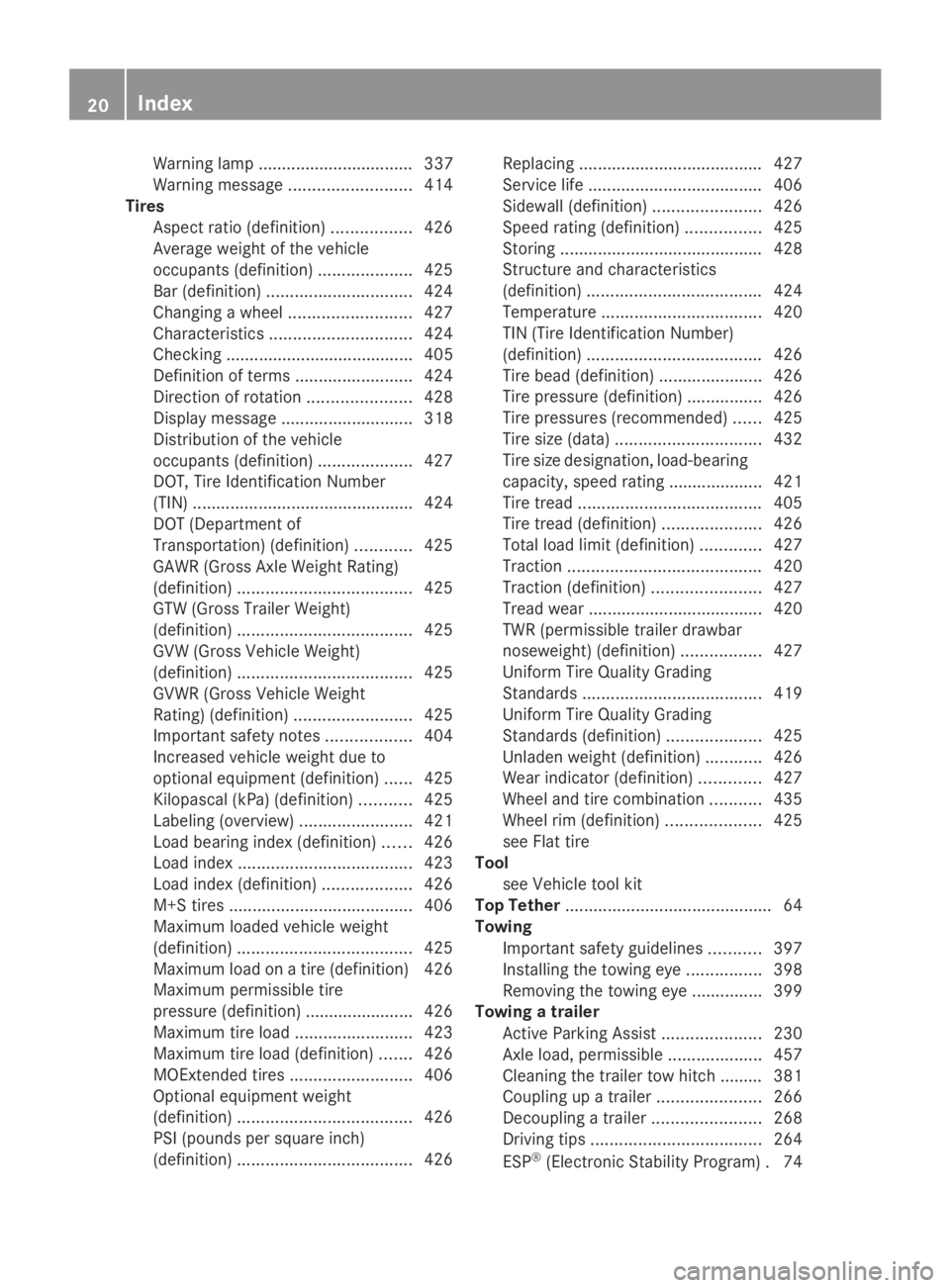
Warning lamp ................................. 337
Warning message..........................414
Tires
Aspect ratio (definition).................426
Average weight of the vehicle
occupants (definition)....................425
Bar (definition)...............................424
Changing a wheel..........................427
Characteristics..............................424
Checking ........................................ 405
Definition of terms.........................424
Direction of rotation......................428
Display message............................318
Distribution of the vehicle
occupants (definition)....................427
DOT, Tire Identification Number
(TIN) ...............................................424
DOT (Department of
Transportation) (definition)............425
GAWR (Gross Axle Weight Rating)
(definition).....................................425
GTW (Gross Trailer Weight)
(definition).....................................425
GVW (Gross Vehicle Weight)
(definition).....................................425
GVWR (Gross Vehicle Weight
Rating) (definition).........................425
Important safety notes..................404
Increased vehicle weight due to
optional equipment (definition)......425
Kilopascal (kPa) (definition)...........425
Labeling (overview)........................421
Load bearing index (definition)......426
Load index.....................................423
Load index (definition)...................426
M+S tires.......................................406
Maximum loaded vehicle weight
(definition).....................................425
Maximum load on a tire (definition) 426
Maximum permissible tire
pressure (definition) ....................... 426
Maximum tire load.........................423
Maximum tire load (definition).......426
MOExtended tires..........................406
Optional equipment weight
(definition).....................................426
PSI (pounds per square inch)
(definition).....................................426
Replacing.......................................427
Service life.....................................406
Sidewall (definition).......................426
Speed rating (definition)................425
Storing...........................................428
Structure and characteristics
(definition).....................................424
Temperature..................................420
TIN (Tire Identification Number)
(definition).....................................426
Tire bead (definition)......................426
Tire pressure (definition)................426
Tire pressures (recommended)......425
Tire size (data)...............................432
Tire size designation, load-bearing
capacity, speed rating .................... 421
Tire tread.......................................405
Tire tread (definition).....................426
Total load limit (definition).............427
Traction.........................................420
Traction (definition).......................427
Tread wear.....................................420
TWR (permissible trailer drawbar
noseweight) (definition).................427
Uniform Tire Quality Grading
Standards......................................419
Uniform Tire Quality Grading
Standards (definition)....................425
Unladen weight (definition)............426
Wear indicator (definition).............427
Wheel and tire combination...........435
Wheel rim (definition)....................425
see Flat tire
Tool
see Vehicle tool kit
Top Tether............................................64
Towing
Important safety guidelines...........397
Installing the towing eye................398
Removing the towing eye...............399
Towing a trailer
Active Parking Assist.....................230
Axle load, permissible....................457
Cleaning the trailer tow hitch ......... 381
Coupling up a trailer......................266
Decoupling a trailer.......................268
Driving tips....................................264
ESP®(Electronic Stability Program).74
20Index
Page 24 of 462
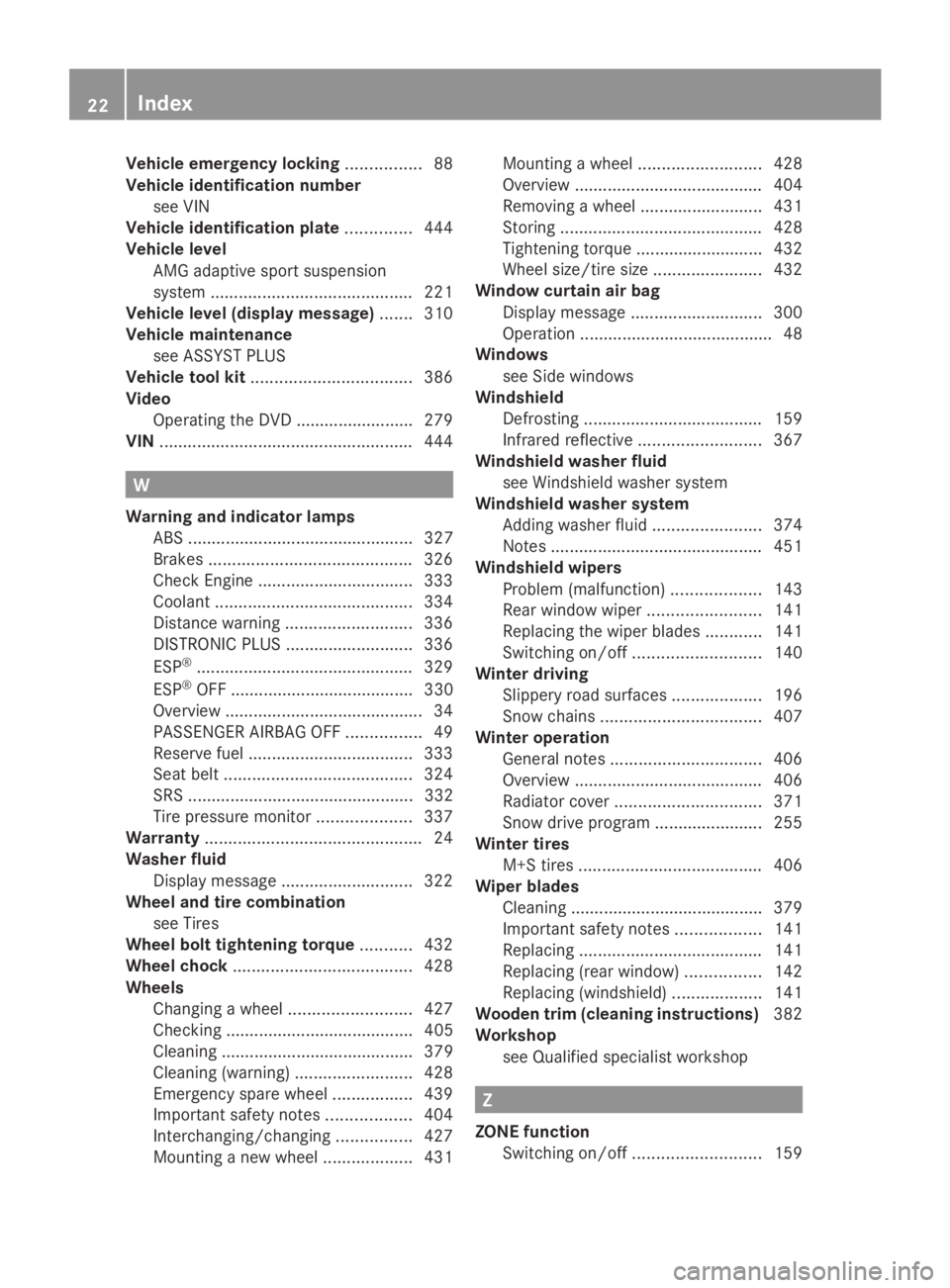
Vehicle emergency locking................88
Vehicle identification number
see VIN
Vehicle identification plate..............444
Vehicle level
AMG adaptive sport suspension
system...........................................221
Vehicle level (display message).......310
Vehicle maintenance
see ASSYST PLUS
Vehicle tool kit..................................386
Video
Operating the DVD ......................... 279
VIN......................................................444
W
Warning and indicator lamps
ABS ................................................ 327
Brakes...........................................326
Check Engine.................................333
Coolant..........................................334
Distance warning...........................336
DISTRONIC PLUS...........................336
ESP®..............................................329
ESP®OFF ....................................... 330
Overview..........................................34
PASSENGER AIRBAG OFF................49
Reserve fuel...................................333
Seat belt........................................324
SRS ................................................ 332
Tire pressure monitor....................337
Warranty..............................................24
Washer fluid
Display message............................322
Wheel and tire combination
see Tires
Wheel bolt tightening torque...........432
Wheel chock......................................428
Wheels
Changing a wheel..........................427
Checking ........................................ 405
Cleaning ......................................... 379
Cleaning (warning).........................428
Emergency spare wheel.................439
Important safety notes..................404
Interchanging/changing................427
Mounting a new wheel...................431
Mounting a wheel..........................428
Overview........................................404
Removing a wheel..........................431
Storing...........................................428
Tightening torque ........................... 432
Wheel size/tire size.......................432
Window curtain air bag
Display message............................300
Operation .........................................48
Windows
see Side windows
Windshield
Defrosting......................................159
Infrared reflective..........................367
Windshield washer fluid
see Windshield washer system
Windshield washer system
Adding washer fluid.......................374
Notes.............................................451
Windshield wipers
Problem (malfunction)...................143
Rear window wiper........................141
Replacing the wiper blades............141
Switching on/off...........................140
Winter driving
Slippery road surfaces...................196
Snow chains..................................407
Winter operation
General notes................................406
Overview........................................406
Radiator cover...............................371
Snow drive program ....................... 255
Winter tires
M+S tires.......................................406
Wiper blades
Cleaning ......................................... 379
Important safety notes..................141
Replacing.......................................141
Replacing (rear window)................142
Replacing (windshield)...................141
Wooden trim (cleaning instructions)382
Workshop
see Qualified specialist workshop
Z
ZONE function
Switching on/off...........................159
22Index
Page 47 of 462
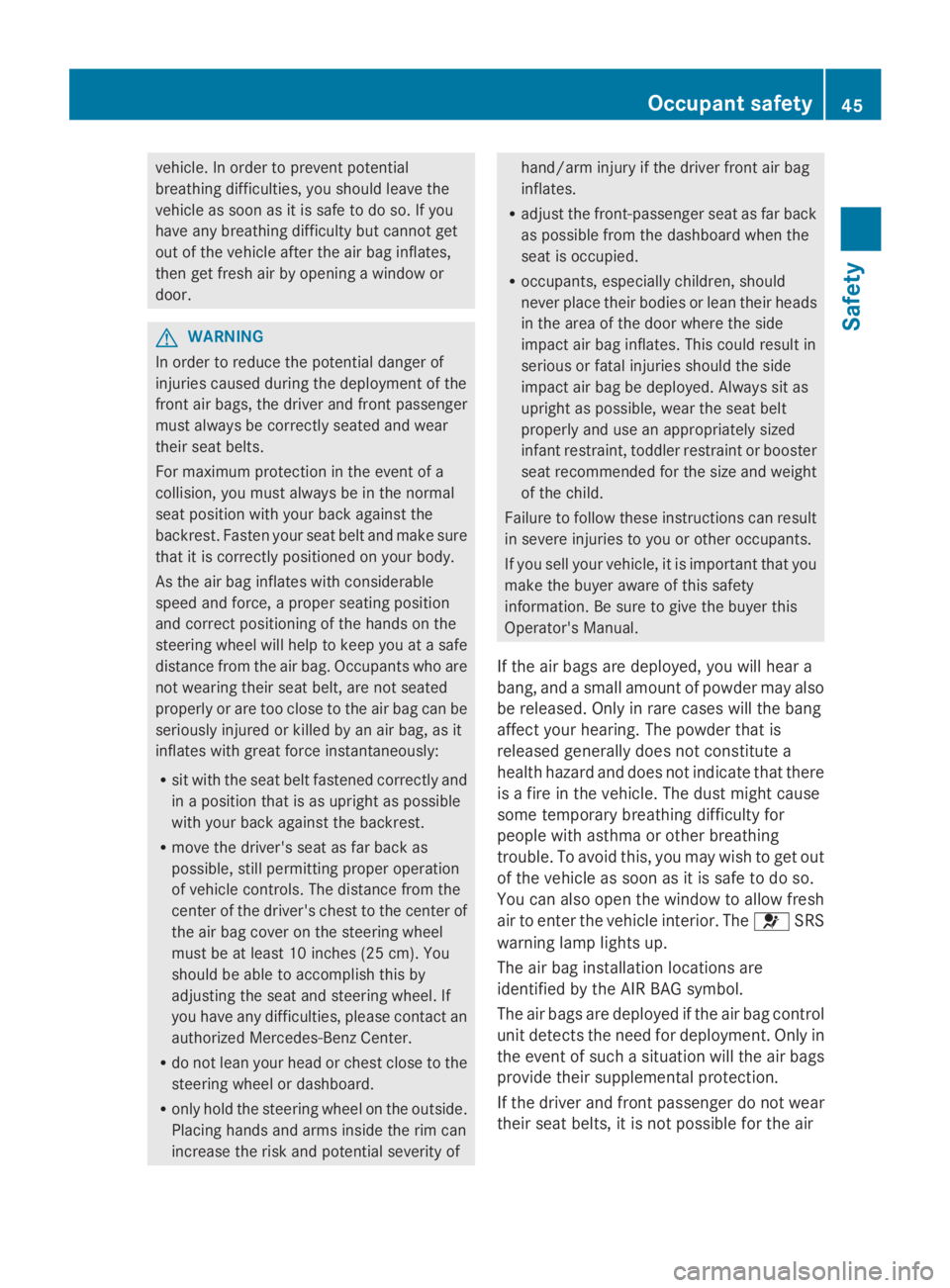
vehicle. In order to prevent potential
breathing difficulties, you should leave the
vehicle as soon as it is safe to do so. If you
have any breathing difficulty but cannot get
out of the vehicle after the air bag inflates,
then get fresh air by opening a window or
door.
GWARNING
In order to reduce the potential danger of
injuries caused during the deployment of the
front air bags, the driver and front passenger
must always be correctly seated and wear
their seat belts.
For maximum protection in the event of a
collision, you must always be in the normal
seat position with your back against the
backrest. Fasten your seat belt and make sure
that it is correctly positioned on your body.
As the air bag inflates with considerable
speed and force, a proper seating position
and correct positioning of the hands on the
steering wheel will help to keep you at a safe
distance from the air bag. Occupants who are
not wearing their seat belt, are not seated
properly or are too close to the air bag can be
seriously injured or killed by an air bag, as it
inflates with great force instantaneously:
Rsit with the seat belt fastened correctly and
in a position that is as upright as possible
with your back against the backrest.
Rmove the driver's seat as far back as
possible, still permitting proper operation
of vehicle controls. The distance from the
center of the driver's chest to the center of
the air bag cover on the steering wheel
must be at least 10 inches (25 cm). You
should be able to accomplish this by
adjusting the seat and steering wheel. If
you have any difficulties, please contact an
authorized Mercedes-Benz Center.
Rdo not lean your head or chest close to the
steering wheel or dashboard.
Ronly hold the steering wheel on the outside.
Placing hands and arms inside the rim can
increase the risk and potential severity of
hand/arm injury if the driver front air bag
inflates.
Radjust the front-passenger seat as far back
as possible from the dashboard when the
seat is occupied.
Roccupants, especially children, should
never place their bodies or lean their heads
in the area of the door where the side
impact air bag inflates. This could result in
serious or fatal injuries should the side
impact air bag be deployed. Always sit as
upright as possible, wear the seat belt
properly and use an appropriately sized
infant restraint, toddler restraint or booster
seat recommended for the size and weight
of the child.
Failure to follow these instructions can result
in severe injuries to you or other occupants.
If you sell your vehicle, it is important that you
make the buyer aware of this safety
information. Be sure to give the buyer this
Operator's Manual.
If the air bags are deployed, you will hear a
bang, and a small amount of powder may also
be released. Only in rare cases will the bang
affect your hearing. The powder that is
released generally does not constitute a
health hazard and does not indicate that there
is a fire in the vehicle. The dust might cause
some temporary breathing difficulty for
people with asthma or other breathing
trouble. To avoid this, you may wish to get out
of the vehicle as soon as it is safe to do so.
You can also open the window to allow fresh
air to enter the vehicle interior. The�uSRS
warning lamp lights up.
The air bag installation locations are
identified by the AIR BAG symbol.
The air bags are deployed if the air bag control
unit detects the need for deployment. Only in
the event of such a situation will the air bags
provide their supplemental protection.
If the driver and front passenger do not wear
their seat belts, it is not possible for the air
Occupant safety45
Safety
Z
Page 124 of 462
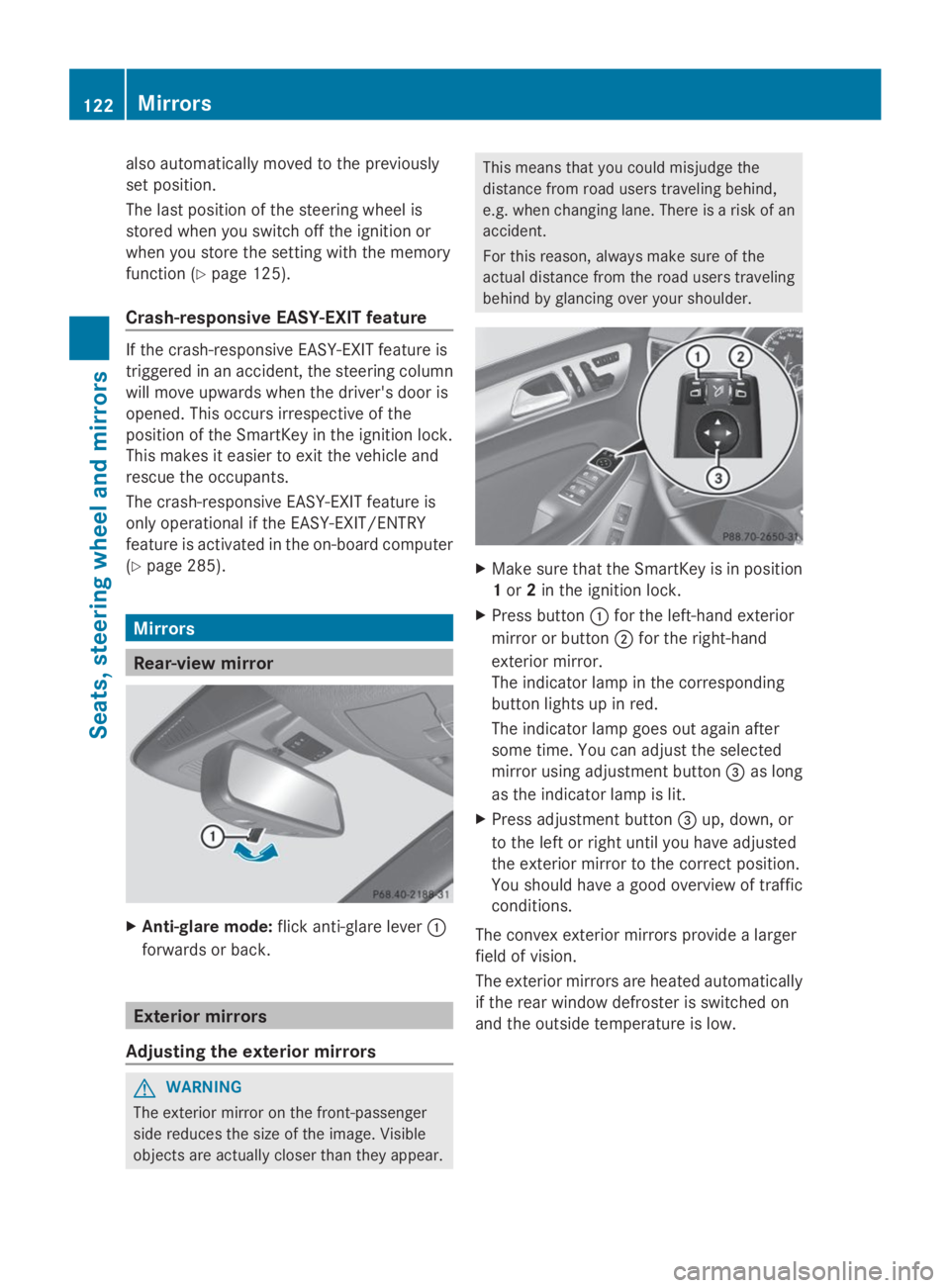
also automatically moved to the previously
set position.
The last position of the steering wheel is
stored when you switch off the ignition or
when you store the setting with the memory
function (Ypage 125).
Crash-responsive EASY-EXIT feature
If the crash-responsive EASY-EXIT feature is
triggered in an accident, the steering column
will move upwards when the driver's door is
opened. This occurs irrespective of the
position of the SmartKey in the ignition lock.
This makes it easier to exit the vehicle and
rescue the occupants.
The crash-responsive EASY-EXIT feature is
only operational if the EASY-EXIT/ENTRY
feature is activated in the on-board computer
(Ypage 285).
Mirrors
Rear-view mirror
XAnti-glare mode:flick anti-glare lever�C
forwards or back.
Exterior mirrors
Adjusting the exterior mirrors
GWARNING
The exterior mirror on the front-passenger
side reduces the size of the image. Visible
objects are actually closer than they appear.
This means that you could misjudge the
distance from road users traveling behind,
e.g. when changing lane. There is a risk of an
accident.
For this reason, always make sure of the
actual distance from the road users traveling
behind by glancing over your shoulder.
XMake sure that the SmartKey is in position
1or2in the ignition lock.
XPress button�Cfor the left-hand exterior
mirror or button�Dfor the right-hand
exterior mirror.
The indicator lamp in the corresponding
button lights up in red.
The indicator lamp goes out again after
some time. You can adjust the selected
mirror using adjustment button�
Page 342 of 462
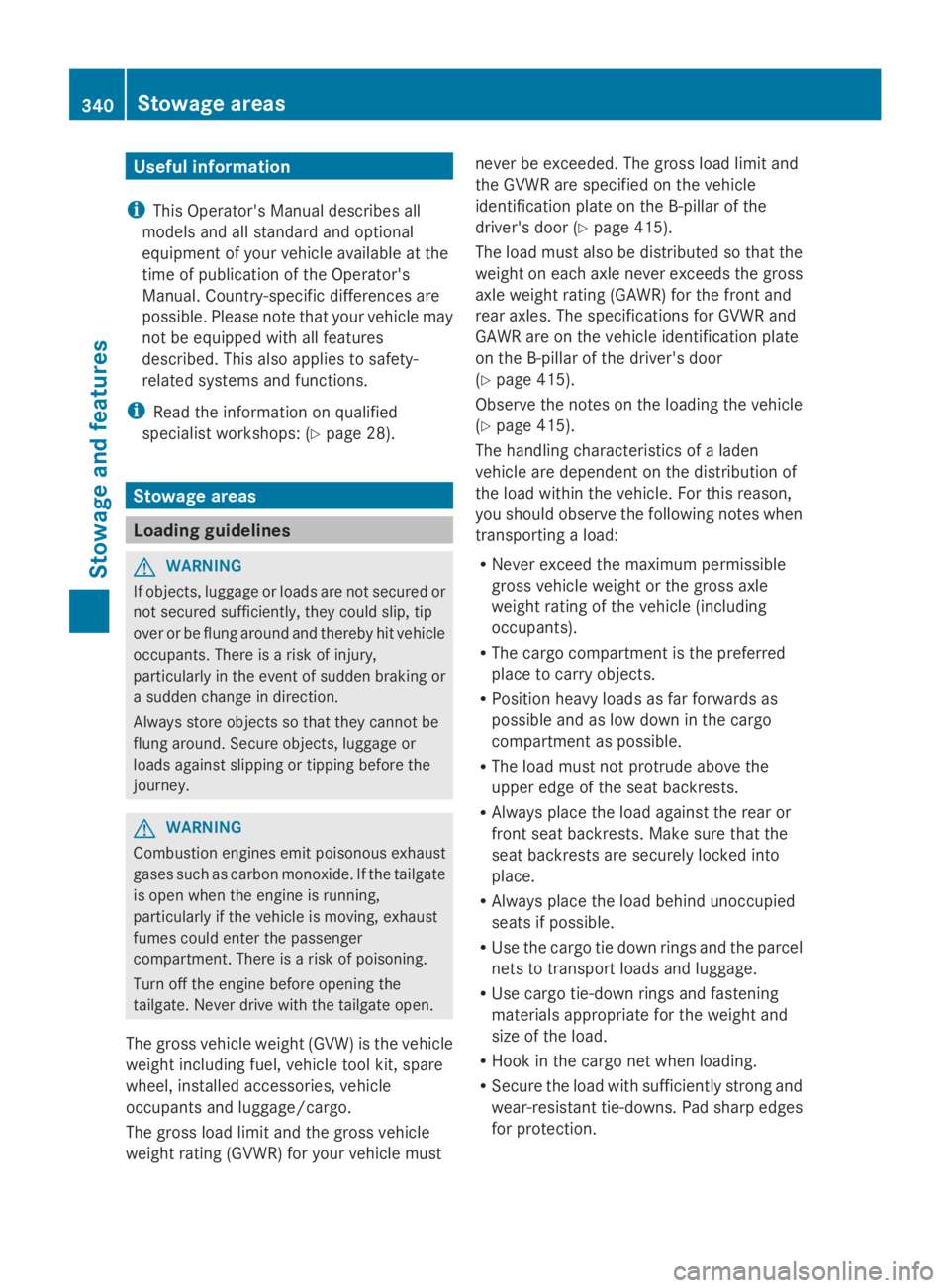
Useful information
iThis Operator's Manual describes all
models and all standard and optional
equipment of your vehicle available at the
time of publication of the Operator's
Manual. Country-specific differences are
possible. Please note that your vehicle may
not be equipped with all features
described. This also applies to safety-
related systems and functions.
iRead the information on qualified
specialist workshops: (Ypage 28).
Stowage areas
Loading guidelines
GWARNING
If objects, luggage or loads are not secured or
not secured sufficiently, they could slip, tip
over or be flung around and thereby hit vehicle
occupants. There is a risk of injury,
particularly in the event of sudden braking or
a sudden change in direction.
Always store objects so that they cannot be
flung around. Secure objects, luggage or
loads against slipping or tipping before the
journey.
GWARNING
Combustion engines emit poisonous exhaust
gases such as carbon monoxide. If the tailgate
is open when the engine is running,
particularly if the vehicle is moving, exhaust
fumes could enter the passenger
compartment. There is a risk of poisoning.
Turn off the engine before opening the
tailgate. Never drive with the tailgate open.
The gross vehicle weight (GVW) is the vehicle
weight including fuel, vehicle tool kit, spare
wheel, installed accessories, vehicle
occupants and luggage/cargo.
The gross load limit and the gross vehicle
weight rating (GVWR) for your vehicle must
never be exceeded. The gross load limit and
the GVWR are specified on the vehicle
identification plate on the B-pillar of the
driver's door (Ypage 415).
The load must also be distributed so that the
weight on each axle never exceeds the gross
axle weight rating (GAWR) for the front and
rear axles. The specifications for GVWR and
GAWR are on the vehicle identification plate
on the B-pillar of the driver's door
(Ypage 415).
Observe the notes on the loading the vehicle
(Ypage 415).
The handling characteristics of a laden
vehicle are dependent on the distribution of
the load within the vehicle. For this reason,
you should observe the following notes when
transporting a load:
RNever exceed the maximum permissible
gross vehicle weight or the gross axle
weight rating of the vehicle (including
occupants).
RThe cargo compartment is the preferred
place to carry objects.
RPosition heavy loads as far forwards as
possible and as low down in the cargo
compartment as possible.
RThe load must not protrude above the
upper edge of the seat backrests.
RAlways place the load against the rear or
front seat backrests. Make sure that the
seat backrests are securely locked into
place.
RAlways place the load behind unoccupied
seats if possible.
RUse the cargo tie down rings and the parcel
nets to transport loads and luggage.
RUse cargo tie-down rings and fastening
materials appropriate for the weight and
size of the load.
RHook in the cargo net when loading.
RSecure the load with sufficiently strong and
wear-resistant tie-downs. Pad sharp edges
for protection.
340Stowage areas
Stowage and features
Page 390 of 462
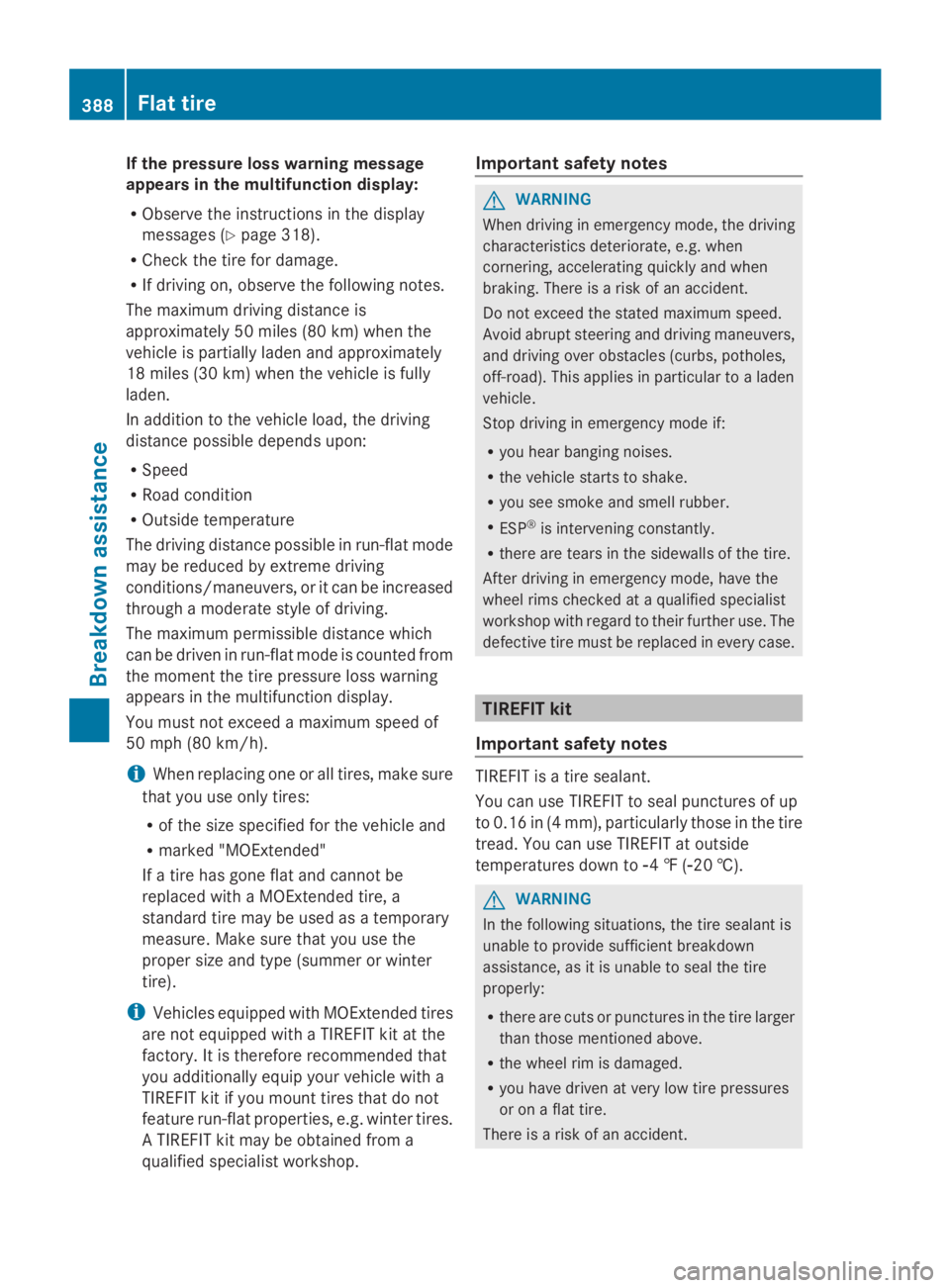
If the pressure loss warning message
appears in the multifunction display:
RObserve the instructions in the display
messages (Ypage 318).
RCheck the tire for damage.
RIf driving on, observe the following notes.
The maximum driving distance is
approximately 50 miles (80 km) when the
vehicle is partially laden and approximately
18 miles (30 km) when the vehicle is fully
laden.
In addition to the vehicle load, the driving
distance possible depends upon:
RSpeed
RRoad condition
ROutside temperature
The driving distance possible in run-flat mode
may be reduced by extreme driving
conditions/maneuvers, or it can be increased
through a moderate style of driving.
The maximum permissible distance which
can be driven in run-flat mode is counted from
the moment the tire pressure loss warning
appears in the multifunction display.
You must not exceed a maximum speed of
50 mph (80 km/h).
iWhen replacing one or all tires, make sure
that you use only tires:
Rof the size specified for the vehicle and
Rmarked "MOExtended"
If a tire has gone flat and cannot be
replaced with a MOExtended tire, a
standard tire may be used as a temporary
measure. Make sure that you use the
proper size and type (summer or winter
tire).
iVehicles equipped with MOExtended tires
are not equipped with a TIREFIT kit at the
factory. It is therefore recommended that
you additionally equip your vehicle with a
TIREFIT kit if you mount tires that do not
feature run-flat properties, e.g. winter tires.
A TIREFIT kit may be obtained from a
qualified specialist workshop.
Important safety notes
GWARNING
When driving in emergency mode, the driving
characteristics deteriorate, e.g. when
cornering, accelerating quickly and when
braking. There is a risk of an accident.
Do not exceed the stated maximum speed.
Avoid abrupt steering and driving maneuvers,
and driving over obstacles (curbs, potholes,
off-road). This applies in particular to a laden
vehicle.
Stop driving in emergency mode if:
Ryou hear banging noises.
Rthe vehicle starts to shake.
Ryou see smoke and smell rubber.
RESP®is intervening constantly.
Rthere are tears in the sidewalls of the tire.
After driving in emergency mode, have the
wheel rims checked at a qualified specialist
workshop with regard to their further use. The
defective tire must be replaced in every case.
TIREFIT kit
Important safety notes
TIREFIT is a tire sealant.
You can use TIREFIT to seal punctures of up
to 0.16 in (4 mm), particularly those in the tire
tread. You can use TIREFIT at outside
temperatures down to�
Page 406 of 462
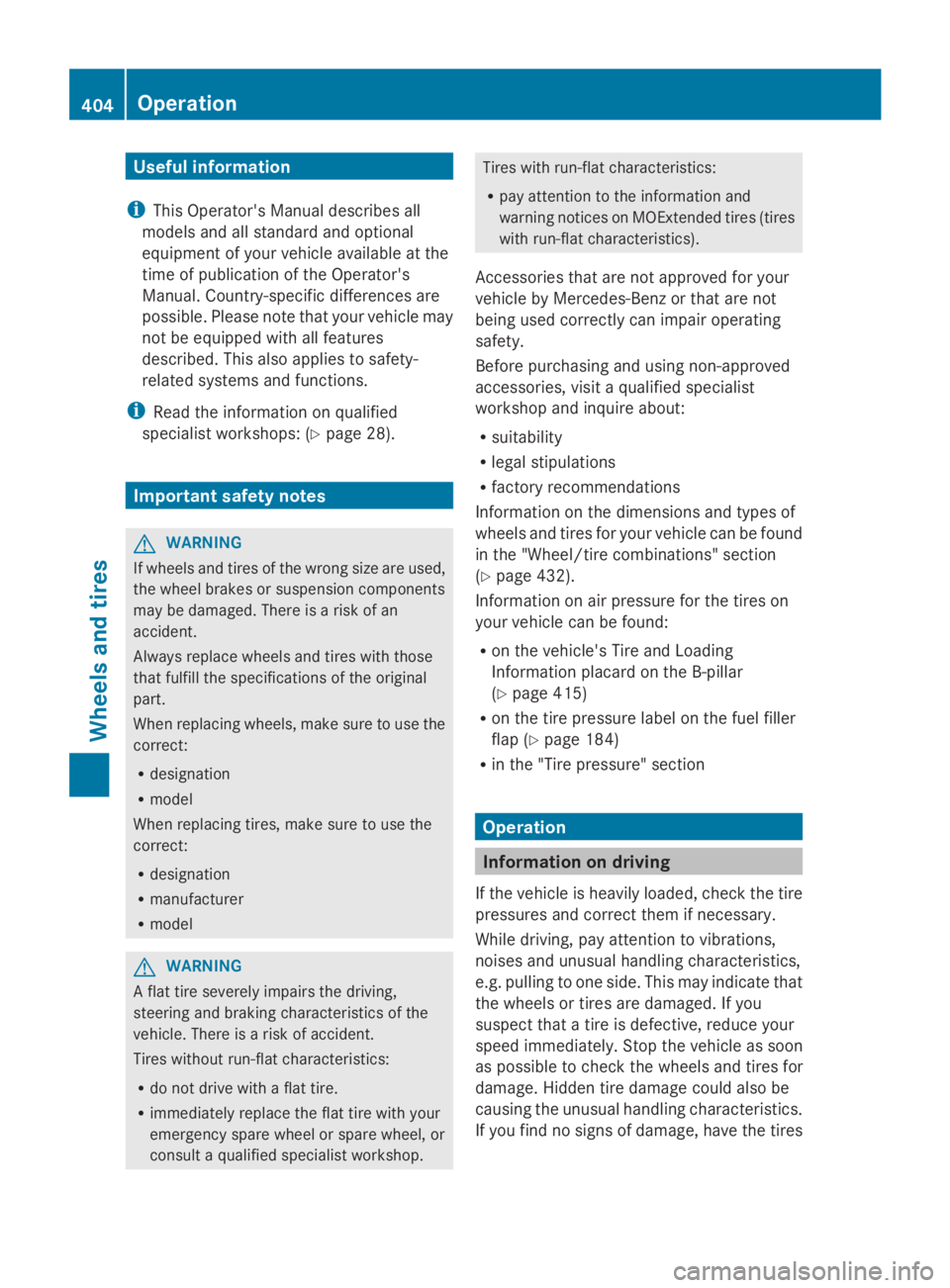
Useful information
iThis Operator's Manual describes all
models and all standard and optional
equipment of your vehicle available at the
time of publication of the Operator's
Manual. Country-specific differences are
possible. Please note that your vehicle may
not be equipped with all features
described. This also applies to safety-
related systems and functions.
iRead the information on qualified
specialist workshops: (Ypage 28).
Important safety notes
GWARNING
If wheels and tires of the wrong size are used,
the wheel brakes or suspension components
may be damaged. There is a risk of an
accident.
Always replace wheels and tires with those
that fulfill the specifications of the original
part.
When replacing wheels, make sure to use the
correct:
Rdesignation
Rmodel
When replacing tires, make sure to use the
correct:
Rdesignation
Rmanufacturer
Rmodel
GWARNING
A flat tire severely impairs the driving,
steering and braking characteristics of the
vehicle. There is a risk of accident.
Tires without run-flat characteristics:
Rdo not drive with a flat tire.
Rimmediately replace the flat tire with your
emergency spare wheel or spare wheel, or
consult a qualified specialist workshop.
Tires with run-flat characteristics:
Rpay attention to the information and
warning notices on MOExtended tires (tires
with run-flat characteristics).
Accessories that are not approved for your
vehicle by Mercedes-Benz or that are not
being used correctly can impair operating
safety.
Before purchasing and using non-approved
accessories, visit a qualified specialist
workshop and inquire about:
Rsuitability
Rlegal stipulations
Rfactory recommendations
Information on the dimensions and types of
wheels and tires for your vehicle can be found
in the "Wheel/tire combinations" section
(Ypage 432).
Information on air pressure for the tires on
your vehicle can be found:
Ron the vehicle's Tire and Loading
Information placard on the B-pillar
(Ypage 415)
Ron the tire pressure label on the fuel filler
flap (Ypage 184)
Rin the "Tire pressure" section
Operation
Information on driving
If the vehicle is heavily loaded, check the tire
pressures and correct them if necessary.
While driving, pay attention to vibrations,
noises and unusual handling characteristics,
e.g. pulling to one side. This may indicate that
the wheels or tires are damaged. If you
suspect that a tire is defective, reduce your
speed immediately. Stop the vehicle as soon
as possible to check the wheels and tires for
damage. Hidden tire damage could also be
causing the unusual handling characteristics.
If you find no signs of damage, have the tires
404Operation
Wheels and tires
Page 409 of 462
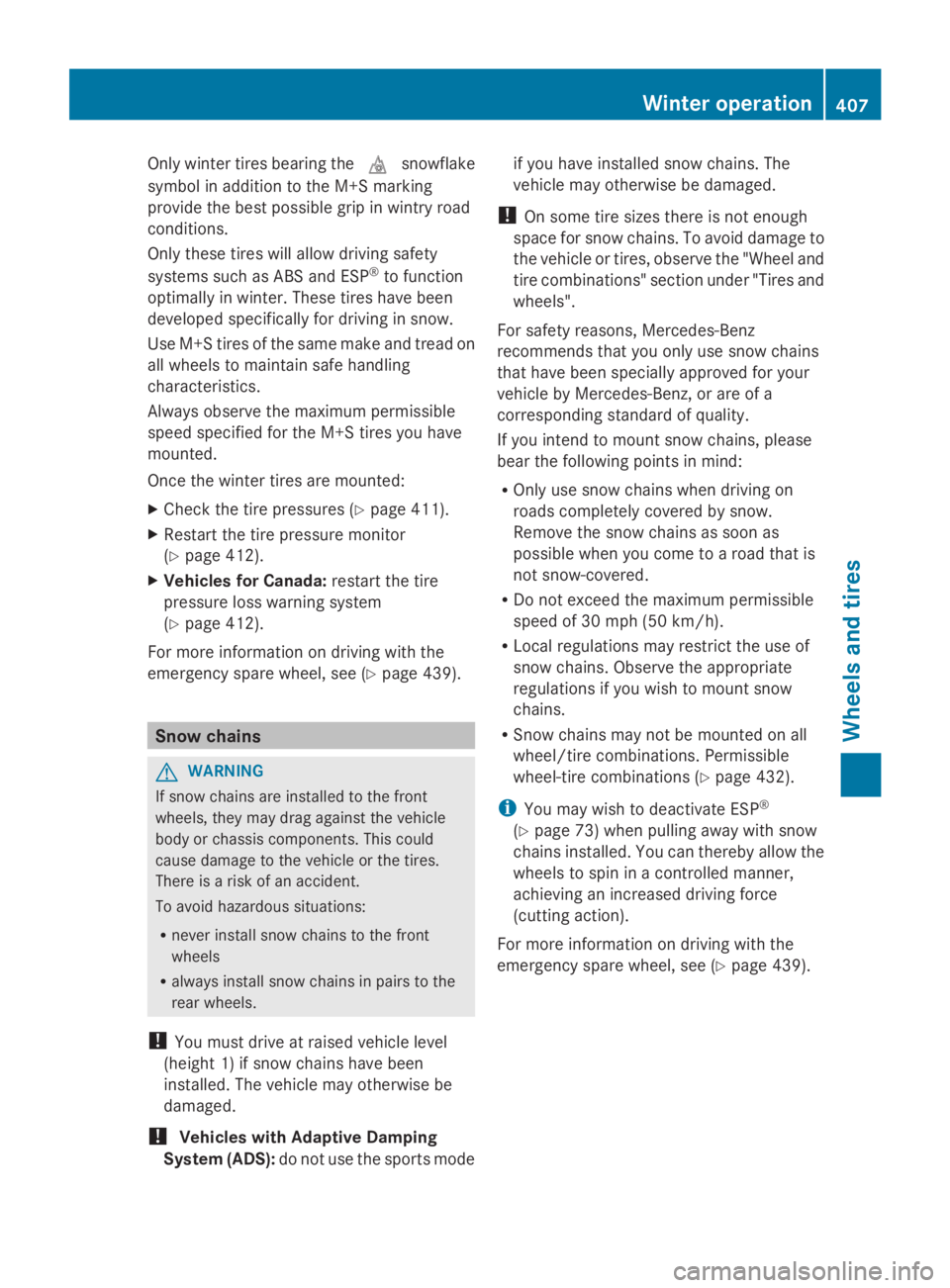
Only winter tires bearing the�Msnowflake
symbol in addition to the M+S marking
provide the best possible grip in wintry road
conditions.
Only these tires will allow driving safety
systems such as ABS and ESP®to function
optimally in winter. These tires have been
developed specifically for driving in snow.
Use M+S tires of the same make and tread on
all wheels to maintain safe handling
characteristics.
Always observe the maximum permissible
speed specified for the M+S tires you have
mounted.
Once the winter tires are mounted:
XCheck the tire pressures (Ypage 411).
XRestart the tire pressure monitor
(Ypage 412).
XVehicles for Canada:restart the tire
pressure loss warning system
(Ypage 412).
For more information on driving with the
emergency spare wheel, see (Ypage 439).
Snow chains
GWARNING
If snow chains are installed to the front
wheels, they may drag against the vehicle
body or chassis components. This could
cause damage to the vehicle or the tires.
There is a risk of an accident.
To avoid hazardous situations:
Rnever install snow chains to the front
wheels
Ralways install snow chains in pairs to the
rear wheels.
!You must drive at raised vehicle level
(height 1) if snow chains have been
installed. The vehicle may otherwise be
damaged.
!Vehicles with Adaptive Damping
System (ADS):do not use the sports mode
if you have installed snow chains. The
vehicle may otherwise be damaged.
!On some tire sizes there is not enough
space for snow chains. To avoid damage to
the vehicle or tires, observe the "Wheel and
tire combinations" section under "Tires and
wheels".
For safety reasons, Mercedes-Benz
recommends that you only use snow chains
that have been specially approved for your
vehicle by Mercedes-Benz, or are of a
corresponding standard of quality.
If you intend to mount snow chains, please
bear the following points in mind:
ROnly use snow chains when driving on
roads completely covered by snow.
Remove the snow chains as soon as
possible when you come to a road that is
not snow-covered.
RDo not exceed the maximum permissible
speed of 30 mph (50 km/h).
RLocal regulations may restrict the use of
snow chains. Observe the appropriate
regulations if you wish to mount snow
chains.
RSnow chains may not be mounted on all
wheel/tire combinations. Permissible
wheel-tire combinations (Ypage 432).
iYou may wish to deactivate ESP®
(Ypage 73) when pulling away with snow
chains installed. You can thereby allow the
wheels to spin in a controlled manner,
achieving an increased driving force
(cutting action).
For more information on driving with the
emergency spare wheel, see (Ypage 439).
Winter operation407
Wheels and tires
Z